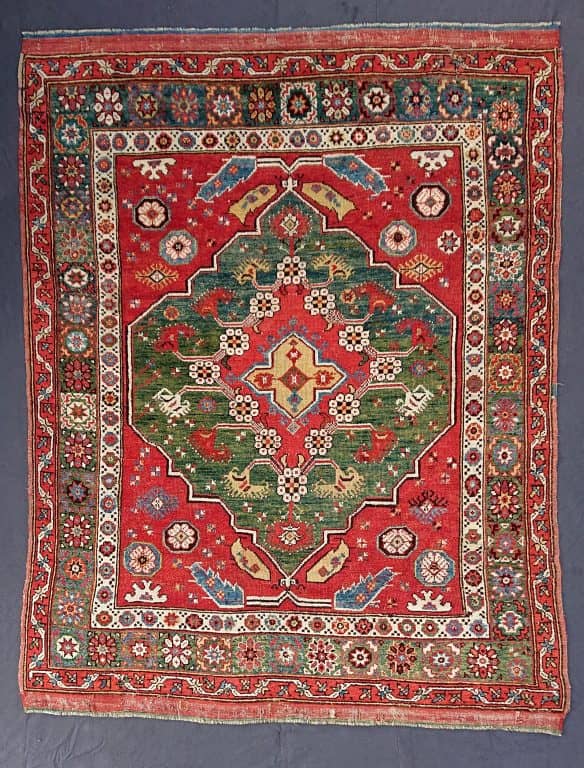Turkish Dazkırı Rug
Description
This Turkish Dazkırı rug dates tot he early 19th century. It was made by a village weaver in the Menderes River area of southwestern Anatolia.
The striking design and colour combinations follow the classic format of Dazkırı rugs: a large green central medallion almost completely fills the red field. It incorporates two further, concentrically arranged medallions in red and a soft, custard yellow, with a cruciform centre. A string of twelve interconnected rosettes forms the border between the outer green and the inner red medallion, with a fan-shaped plant element emanating from the connective lines and protruding into the green medallion. Individually placed rosettes and two sets of leaf pairs at the top and bottom ends of the outer medallion decorate the field.
A sequence of three borders encloses the field: the main border on a green ground is a string of squares which are filled with a rosette or a star each, echoing the rosettes in the field. This border is flanked by a narrower border on a white ground, again filled with stars/rosettes which are separated by a V-shaped arrangement of three small, dark brown squares. A meandering border on a red ground follows on the edges of the rug. Original kelim ends in red and green and in red and blue form the bottom and top ends.
Not very many rugs of this type and age are known – according to HALI, “at least twelve such pieces have been published” (HALI 206, Winter 2020, p. 122). That does not constitute a large number in the body of carpet publications. Our piece, which is new to the market, can be added to this list.
In a contribution to HALI, Brian Morehouse discusses “Menderes Valley Carpets” (HALI 121, March/April 2002, pp. 101 – 107). He identifies urban influences, particularly from Ushak, and the “Transylvanian style” which he sees especially evident in the field ornamentation. And, indeed, there is a certain similarity with the design language of a double-niche Ushak rug like the one from the Applied Arts Museum in Budapest that Morehouse includes in his article (op. cit.,fig. 21, p.105). It is quite likely village weavers would have been exposed to rugs from that great centre of weaving, particularly since the Ushak region is situated on the northern edge of the Menderes Valley, so is in close geographical proximity.
The rug in hand is woven in soft wool on a wool foundation. It has a number of old, almost invisible repairs but is overall in very good pile.
This is a rare find for a carpet enthusiast and collector.
SOLD

